Hey guys, as many of you may know, T. sessile is a nuisance pest that lives all around the united states. although I am not sure whether or not they stage nuptial flights or reproduce by fission, I would like to raise a colony. my mom's boyfriends house has a colony that possibly consists of 1 million workers and several queens. if possible, can you answer a few of the questions below?
1) do you raise a colony of these yourself, if so, please post a photo
2) how do they reproduce? if they reproduce via nuptial flights or some other method, what time of year do they do so?
3) what are there humidity / temp. requirements? will they benefit from heating?
4) what foods do they prefer? will they accept formula blue?
5) are they prone to escaping? / do they require multiple satellite nests?





















